The mysterious life of the stars
NASA has published a number of photos of stages in the life of stars, in celebration of the 18th Hubble telescope's birthday.
Mysterious life cycle of stars in the universe
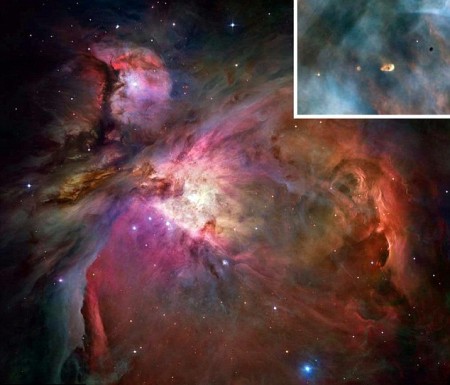
Orion Nebula.(Photo: NASA.)
The first photo shows the Orion nebula - a dense cloud of dust and gas about 1,500 light years from Earth. This nebula has many stars in the process of formation. Inside the smaller rectangle is a disk image of dust and gas surrounding a new star. Over time this disk of dust will create planets.
Stars are born in the dust and gas through many stages. First, the volume of gas dust shrinks so its average density increases. The shrinkage phenomenon is strong and gradually increases over time in high density areas. At some point, the combination of cold air and dust broke into many solid clouds. These small clouds are embryos to form a physical form called "star money".
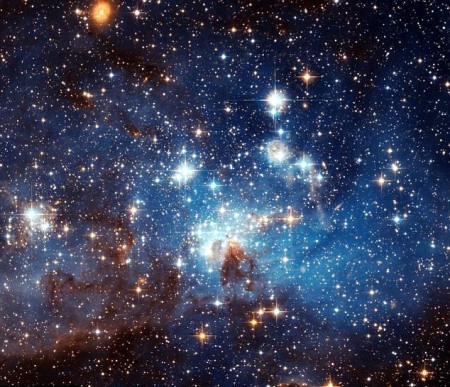
The gas in the Large Magellanic Cloud.(Photo: NASA.)
The second photograph captures new blue stars that are surrounded by gas in the Large Magellanic Cloud - a galaxy containing several billion stars. However, the number of stars in this galaxy is too small for 200-400 billion stars in our Milky Way galaxy.
After the "star money " appears, the contraction process continues with free fall velocity and emits infrared radiation. In its central region, the falling motion of particles takes place faster, forming a dense nucleus that infrared radiation cannot pass through. This situation causes the nuclear temperature of " protostar " and internal pressure to rise very high, thereby reducing the process of contraction.
Dust and gas fall on extremely massive kernels causing shock waves. When these shock waves penetrate the surface of the protostar, the brightness of the "protostar" will increase dramatically and this phenomenon is called "infrared flare". As the gravitational contraction continues, the gas accumulates non-stop on the nucleus, causing its size to shrink and the intensity of light to decrease.
If the mass or luminous intensity of the "protostar" is large enough, most of the air dust from its material shell is stellar (the process of material loss of stars in all stages of evolution) pushes into space. cylinder.
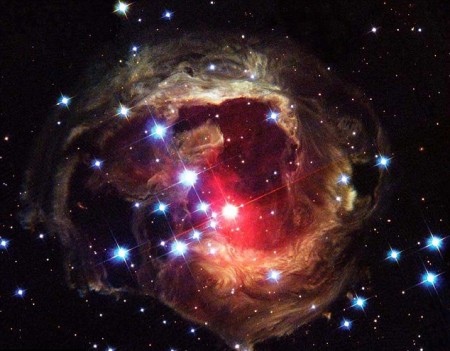
Stars are evolving V838 Monocerotis.(Photo: NASA.)
The third photograph captures an evolving star named V838 Monocerotis . Its rays of light shone on the dust and gas that had been ejected by a wind from before. Stellar winds (with predominantly high-energy electrons and protons) prevent the mass growth of "star money".
This explains why the maximum mass of observed stars is valued at about 60 solar masses. After a period of about 10,000 - 100,000 years, stellar winds will diffuse all the matter around the star. Thus "star money" becomes an observable celestial body.
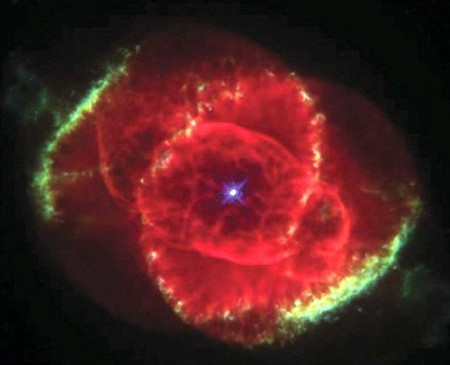
A star is shaking off the outer material.(Photo: NASA.)
In the fourth picture shows a dying blue star, removing its outer layers of material and becoming a white dwarf , while promoting the formation of a nebula.
Gravitational collapse is the phenomenon of ultra-fast contraction of celestial bodies 10 times the mass of the Sun under the force of gravity. It usually occurs at the end of the evolution of a massive body. After incinerating the nuclear fuel, stars and celestial bodies will generally lose mechanical balance (the energy to push matter out of the center of the mind is weakened), leading to the process of compression to the center with speed. ascending.
The process of increasing internal pressure will occur in parallel with the process of compression into the mind. The following two possibilities may occur. First, if the pressure at the center increases large enough to stop the gravitational collapse process, the object will have a center of mass as a solid neutron star. The shell then shot out to form a nebula, the brightness of the celestial body increased millions of times in a short time forming a new star.
Secondly, if the internal pressure of the celestial body is only enough to slow down the gravitational collapse but does not prevent the contraction of matter into the gravitational radius, matter will continue to collapse and the center of mass at that time. become a black hole.
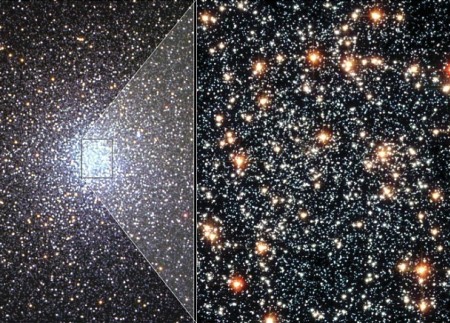
Spherical star system.(Photo: NASA.)
The fifth photograph captures a spherical star system smaller than the galaxies. They usually contain about 10,000 - 1,000,000 stars and have a diameter of several hundred light years. Astronomers have found about 150 spherical star systems in the Milky Way . Because they are too far away from the solar system, we can hardly see them with the naked eye.
- Explain the mystery of missing stars in the universe
- The mysterious death of some stars
- Five stars may have extraterrestrial life
- Find many mysterious extraterrestrial oceans
- 9 interesting things about stars
- Light from the first stars
- Detect suspicious signals of aliens from more than 230 stars
- The first time a revived star was discovered
- Discovering more 'future houses' for humankind
- Lonely stars
- Decoding super-fast stars in 'Ngan river'
- The most exotic new planets 2012
 Van Allen's belt and evidence that the Apollo 11 mission to the Moon was myth
Van Allen's belt and evidence that the Apollo 11 mission to the Moon was myth The levels of civilization in the universe (Kardashev scale)
The levels of civilization in the universe (Kardashev scale) Today Mars, the sun and the Earth are aligned
Today Mars, the sun and the Earth are aligned The Amazon owner announced a secret plan to build a space base for thousands of people
The Amazon owner announced a secret plan to build a space base for thousands of people A shooting star, about to explode in the sky of Earth?
A shooting star, about to explode in the sky of Earth?  Image of a new star spewing gas loudly across the Milky Way galaxy
Image of a new star spewing gas loudly across the Milky Way galaxy  The 'deadly' truth about strange radio signals transmitted to Earth
The 'deadly' truth about strange radio signals transmitted to Earth  Scientists Stunned to Discover Star With Supersonic Tsunamis Three Times Higher Than the Sun
Scientists Stunned to Discover Star With Supersonic Tsunamis Three Times Higher Than the Sun  Death 11.5 Billion Years Ago Bombs NASA: A Chilling Prediction for Us
Death 11.5 Billion Years Ago Bombs NASA: A Chilling Prediction for Us  In 2024, the cosmic monster in the 13th century ancient text will return.
In 2024, the cosmic monster in the 13th century ancient text will return. 